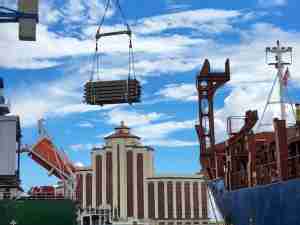U.S. ports are clogged with exports of coking coal for steelmaking, for which the rail companies and ports can charge considerably higher fees, traders said.
"You have thermal exports as well as met coals intended for several international destinations at all U.S. ports," said Brian Gamble, coal analyst at Houston-based Simmons and Co.
"It's creating pressure, frankly, on the whole system."
Fresh flooding in Australia, the world's biggest coal exporter, added another $10 a tonne to thermal prices on Tuesday, driving coal to a yearly high of over $143.00 a ton.
Asian steel mills and utilities have been scrambling to find replacement coal, both thermal and coking..
"The best value coal on the planet is American and it could work to Asia, but I don't think there is much export capacity available," one major European utility trader said.
U.S. thermal coal shipped to Europe works out at around $5.00 a tonne below the prevailing benchmark price of $130 for API2 or delivered Europe coal, they said.
"You would see a lot of U.S. coal coming to Europe at these numbers but you can't get the rail or port capacity to export it," a trader said.
Prices of coal imported to Northwest Europe have hovered around $120 a metric tonne in recent weeks, which translates into about $109 a short ton, the U.S. coal measure.
Coal trader Frank Kolojeski of New Jersey-based Export Commodities International Inc said the economics of shipping U.S. thermal coal to Europe have improved but port capacity capped exports.
"I think you'll see more Illinois Basin coal going to Europe because this year, unlike previous years, there's a lot more Pittsburgh seam coal, which is higher sulfur, going to the met market rather than the steam market," Kolojeski said.
Lost Opportunity
Despite having the highest cash costs globally -- the cost of mining and moving coal to port -- American coal exporters are losing out on the chance to profit by filling the supply gap left by others.
"There could be a little bit of money there," Kolojeski said.
Experts put total export capacity around 130 million short tons annually in an industry that produces 1.1 billion tons of coal per year, according to analysts and government data.
The vast majority of U.S. coal is consumed in domestic power generation.
"You can't just add another million or so tonnes of U.S. coal to exports, especially if you don't have term contracts for port and rail capacity and they're struggling to move what's already booked," a large utility/trader said.
U.S. prices for power-plant coal have risen sharply, briefly blowing past $80 a short ton, and are now in the high $70s because of supply problems in other countries and soaring prices for steel-making coal.
"The U.S. is a very interesting market for us, for everybody now but like every other coal exporting region it's prone to logistical bottlenecks," a Europe-based physical trader said. (Reuters)









